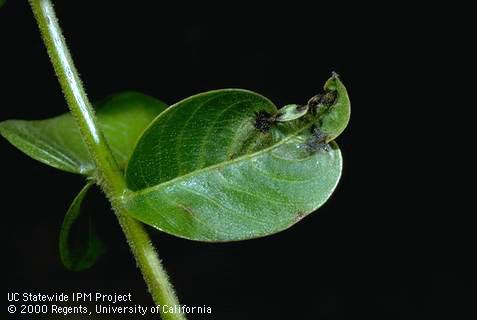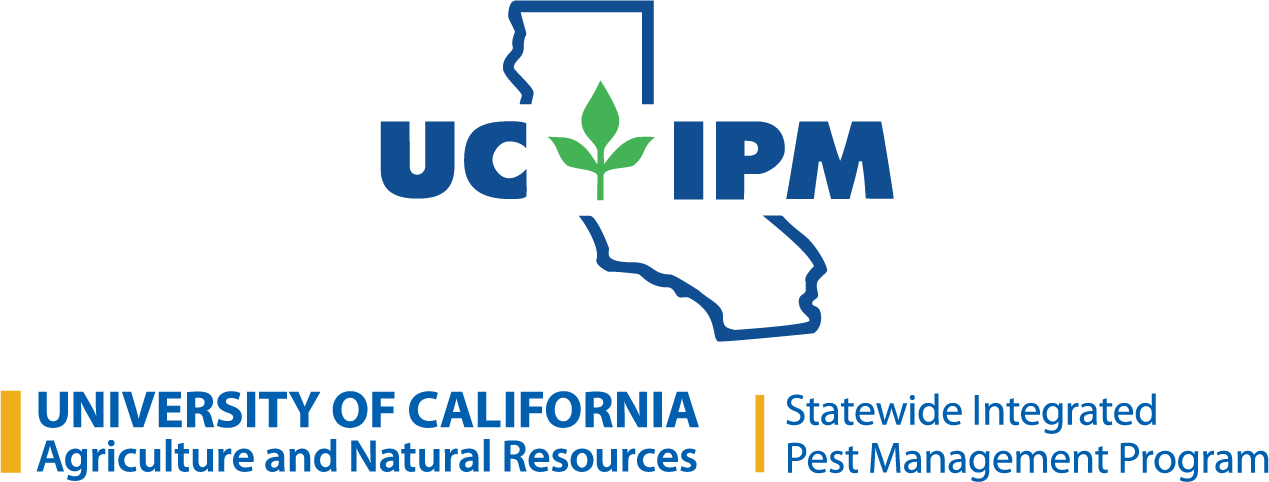Walnut blight is the most serious disease of walnut leaves and young nuts. The disease is caused by a bacterium that infects only Juglans species. It becomes more of a problem when spring rains are abundant or green plant parts are wetted by sprinklers.
Identification
All young, green tissue is susceptible to infection and blackening by the walnut blight bacterium, including buds, female and male flowers, leaves, and developing nuts. Infection of catkins (clusters of male flowers) begins in individual florets, which turn black, die, and shrivel. As the infection spreads, part or all of the catkin blackens and becomes twisted. Female flowers are susceptible even before their stigmas are receptive for pollination.
Shoot infections may cause superficial lesions one to several inches long that can extend into the pith to form cankers. The lesions may girdle and kill young twigs. Symptoms on leaves begin as small dark brown specks surrounded by a yellowish green halo. These infections kill small areas of the leaf. As immature leaves grow and infections spread, tissue folds around the lesions and gives the leaves a twisted appearance. Leaves infected after their growth has been completed develop lesions but do not become distorted. As infections spread, larger areas of dark, dead tissue appear.
In the spring, infected young nuts develop a dark lesion usually at the blossom end. Most of these infected nuts prematurely drop from the tree. As nuts mature, lesions can develop anywhere on the husk. These nuts can remain on the tree. Husk lesions begin as small water-soaked spots that later darken, enlarge, become sunken, and commonly crack. Later these infections darken and shrivel the kernels, lowering the yield quantity and quality.
Sunburn and water stress also darken or shrivel kernels, but these maladies produce husk symptoms different from walnut blight. Husks damaged by water stress are brown to yellow and often shriveled. Sunburn lesions are brown and leathery and limited to the side exposed to the sun. Feeding by larvae of walnut husk fly, a fruit fly, causes black lesions on husks, but the blackened husk tissue is soft and mushy and the kernel is not darkened. Nuts with walnut blight provide a breeding site for navel orangeworm, which makes nuts inedible. The disease can also make it more difficult and unpleasant to harvest the nuts and remove their husk.


Life Cycle
The blight bacterium survives the winter primarily in dormant walnut buds that were infected the previous spring. Some inoculum also survives in infected catkins that remain on the tree. Twig lesions and nut mummies may also harbor the pathogen, but these are not important sources of inoculum.
If plant surfaces are wet during spring, the pathogen spreads from buds infected the previous growing season and infects new growth, such as developing buds, catkins, pistillate (female) flowers, shoots, and young nuts. The bacteria enter the new plant tissue through natural openings such as the stomata (natural openings for gas exchange) on catkins and new leaves.
The severity of blight each season depends on how much overwintering inoculum is present in buds and the amount of wetness that occurs in spring. Blight can develop over a wide range of temperatures, but the initiation of disease drops sharply when rains cease unless green tissue is wetted by sprinklers. Few new infections occur after May.
Damage
Early blooming cultivars are more susceptible to infection because wet weather during bloom favors bacterial infection and growth. When flowers become infected they usually shrivel and drop from the tree, resulting in yield loss. Nut infections are the most common and conspicuous symptoms and the most damaging to yield amount and quality. Infected young nuts generally drop from the tree. When older nuts are infected before the shells harden, the kernels darken, shrivel, and become inedible.

Solutions
Only preventive measures are available to manage walnut blight. Once infection has occurred, nothing can be done to stop bacterial growth in that lesion. The most important management tactics are modification of cultural practices and the application of copper fungicide sprays.
Cultural practices include:
- Avoid irrigating during bloom. Instead, irrigate during prebloom if winter rain was not adequate.
- Prune off lower limbs that tend to become wetted by sprinklers.
- Prune inner, upper limbs of young trees to improve air circulation within the canopy.
- Use drip or flood irrigation where feasible instead of sprinklers.
- If using sprinklers, aim them at a low angle or shield them so water does not wet green tissue of the tree.
If walnut blight was a problem the previous year or spring and rains are expected before or during bloom, the preventive fungicides Bordeaux mixture or another copper fungicide can be sprayed to reduce the extent of infections and nut loss. Thorough coverage of all green tissue is needed for effectiveness. If rainy weather persists, a repeat application is likely warranted. To protect new growth when conditions favor disease development, sprays must be frequent enough and must provide good coverage to replenish the copper coating on plant parts.
References
Adapted from Integrated Pest Management for Walnuts Third Edition and Pest Management Guidelines: Walnut, University of California Statewide Integrated Pest Management Program (UC IPM).
